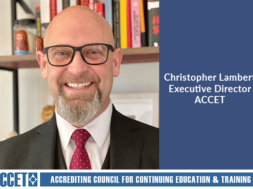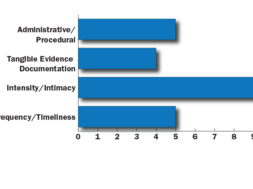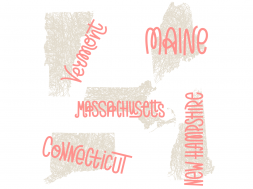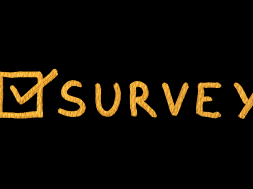
Changing Accreditation Agencies – the Good, the Bad and the Ugly!
By Suzanne Morrison-Williams, Ed.D., Vice President, City College
In the wake of the demise of the Accrediting Council for Independent Colleges and Schools (ACICS), hundreds of schools have found themselves scrambling to find new accreditation. Many did not think the government would take the daunting step to derecognize an accrediting agency who’d been around for more than a century. Schools that were not proactive when the announcement first came out in summer 2016 spent harrowing days and sleepless nights over the holidays attempting to determine which accrediting agency they could now move to.
ACICS schools have 18 months to find a new accreditor. However, schools had to submit a notification to the Department of Education by March 13, 2017, telling them which agency the school would be applying to and the timeline for accreditation in order to meet Federal guidelines for the ability to continue to issue Title IV funds.
Throw into the mix, many states having additional guidelines for ACICS schools and this becomes a formula for mass hysteria and throwing oneself on the floor to have a full on tantrum and meltdown.
However, regardless of where a school is in the process, the key is to create a plan for moving forward. So, first things first. Which accreditation agency will a school pick to make their application? There are too many factors involved in this process to give a solution to this question within this article. However, some key items to consider would be:
- Mission of the institution and mission of the accreditation agency.
- The ability of the institution to meet the standards and outcomes of the accreditation agency.
- The time frame for application and acceptance into the proposed accreditation agency. Time frames can be as short as a year or as long as three years.
- Fiscal health and viability of the institution.
Once a school is able to align these four critical factors and an agency is chosen, then the fun begins!
Keeping the lines of communication open
Please do not ever believe that your students and staff do not keep abreast of the news. They do! When earth shattering issues happen, such as the de-recognition of an accrediting agency, both students and faculty/staff alike will look to the administration as to what the next steps will be. Failure to act in the face of a crisis is not what leadership should be doing. This is the time for leaders and managers to “belly up to the bar” and put out a clear and succinct message about the institution’s plans and how students and constituents will be kept abreast of the plans.
The aim of the message should be to assure students, staff and faculty that the administration is not only keenly aware of the issue but that they are actively working on putting together a strategy that will be of benefit to the students, staff and faculty. Additionally, this communication will serve to alleviate the fears that many will have about whether or not your institution is still a viable option for them to continue their education and or their employment.
If you are a campus leader, the message should come from you to ALL students, staff and faculty.
Allowing others to control the message leads to the “Chinese telephone effect” where messages get distorted by tone, the attitude of others and each person’s take on the situational outcome. Craft a well-worded letter or if you are a great orator, shoot a quick video that seeks to both inform and assure. And this is the time to be VERY conscious of WHOM you pick to deliver the message. Pick someone whose demeanor and voice is calm and assuring. This is the image of the company that you wish to convey.
As you move forward in the accreditation process, the communication channels should remain open with continued updates as to the status of the process. This is also a great way to keep everyone energized and engaged in the process. It will take EVERYONE on the team to get through an initial institutional accreditation process. Tempers will be high, patience will be low and everyone will be on edge. These routine updates and pep talks keep everyone tuned into what the institution needs to accomplish. Letting the team know that their work and efforts are appreciated will go a long way in keeping the team cohesive and intact.
Getting the work done – getting started
An Accreditation visit will probably have the following components:
- An application
- Self-study documents
- Campus or programmatic specialty documents
- Outcome measurements
- Compliance documents and tracking tools
These five items can be comprised of thousands of pages. Collating and/or creating these documents is a mammoth task. It will take a huge level of coordination and collaboration to assemble these documents in order to create a picture of your institution and how it meets the various outcomes and standards of the accreditation agency. It is a daunting task.
HOWEVER, if it is broken down into smaller components and each is assigned to specific groups and or persons with clear goals and deadlines, then the insurmountable will become manageable.
If an institution has multiple campuses, then some tasks should fall to the corporate office. The corporate office should create some blueprint documents which the campus can follow. Any information which is standard across ALL campuses should be assembled within this parent document. Within that document give clear directions to campuses about the information that should be housed in the document. This prevents confusion on the part of the local campuses, and the information will then be standard from one campus and or program to another. This helps to ensure quality control of the documents produced by campuses.
Once this parent document is created, then it should be sent out with a timeline for when each component should be completed. This is a great time to form teams or committees (usually a requirement of most accrediting bodies) to oversee the activities, meetings and achievements of deadlines on the campuses.
Getting the work done – compiling the data
This part can be easy or hard depending upon the norms of your institution. Most accrediting agencies are going to require you to get the ‘data:’
- Student demographic data
- Student retention data
- Student graduation and placement data
- Student licensure and passage rate data
- Satisfaction data (student, employee, graduate)
- Curricular and faculty efficacy data
Once you have this data, what then? Then comes the analysis. Data by itself is useless unless you know what that data means for the advancement of your students and institution. So you need to begin to analyze the data. Sometimes you find that you may not have the manpower on your staff to do this, and sometimes because having never done this before, there’s no one who’s equipped to actually perform this task. Oh dear, now we are stuck!
Now’s the time for the organization to engage in critical thinking and figure out some solutions to problems. If the organization does not have the talent in-house, then it becomes critical to source that talent. Is there a consultant or someone the organization can hire in the short term to help analyze the data and determine the organization’s trajectory? The organization needs a plan to replicate this process for future success. Now the organization knows and can begin formulating a plan to change the paradigm and create new avenues to create success. Sometimes the analysis may yield the finding that the organization is engaged in a losing proposition. Solution: Admit that this is no longer working and find a new path.
Teaching out a program that is no longer serving the organization well is not the end of the world. It’s simply a fact that needs to be managed.
Compiling the data and analyzing the results, if this is not a routine process within your organization, it will become a very enlightening experience for the organization. Many local level managers will begin to see the flaws or highlights of their practices and an organization may see new leadership emerge from this exercise or the revelation of systemic issues. What is clear – is that this is an incredible organizational tool to help the organization be focused on overall organizational improvement and growth.
Where’s the English faculty?
Most educational institutions know the importance of the English faculty for their students. However, the value of having an English faculty as part of an Accreditation team is invaluable. Why? English faculty are accustomed to lots of reading and editing. At every stage of the game, English faculty should be involved in the proofreading and editing of all accreditation documents. When multiple persons are completing documents, suddenly what should be a cohesive document is written in multiple writing styles with dubious punctuation and non-existent spelling accuracy. These purveyors of the proverbial red pen will ensure that institutional documents are cohesive and error free.
Double check and triple check
Before an organization gets started with the writing process, it should be clear ALL the documents which will be needed to complete the process. Once all the documents have been assembled and “professor red pen edit” has done a thorough proofreading of the document, it is time to assemble the entire package. Remember, there will be thousands of pages to assemble. As such, the more persons who are reviewing this, the better. Be very clear on the requirements of the agency and how they want documents submitted to them. Follow those instructions very carefully.
One of the MOST critical items to pay attention to is the date when applications should be submitted. There is no worse impression to make than to be late with an application. The goal should be to submit the application at least one week in advance. If it needs to be mailed, factor in time for mail delays, especially due to inclement weather or technical issues. Once you are satisfied that the documents are in great shape, then go ahead and submit them. Then take a huge breath. Stage one is now complete.
Setting the stage for the site visit
Stage one? What do you mean stage one? There’s more? Yep! Now the institution has the opportunity to show itself off to the accreditors. Here’s the crux of accreditation. All those thousands of pages the institution submitted need to be verified by an impartial third entity of peers. They will come onto the campus in a very collegial manner in order to ascertain that the processes and standards you discuss are actually done in practice. They will also verify all of your compliance points, and ensure that your outcomes align with the accreditors. This process can be a very nerve-wracking one for the campus personnel; but if properly prepared it will be a simple process.
This is probably the most nerve-wracking part of the process. If you have the benefit of working with someone who is familiar with the agency with whom you are seeking accreditation, now is the time to work with that person. Know the specific things the agency is looking for and work to ensure that all those items are in tip top shape. Read, read and read a third time what their requirements are and then endeavor as best as you can to meet those requirements. Having MULTIPLE people as part of this process is critical. Why? Because there are multiple views on a situation and all those views can be taken into account and action items implemented.
Having multiple people voicing opinions and giving multiple directives to local campus teams will give way to frustration, inefficiency and ill feeling on the part of the campus. So make decisions and then roll them out. The closer an institution gets to a visit the FEWER things they should be attempting to implement. Why? This simply raises the frustration and fear level of the campus. It also undermines campus confidence in management.
So forward planning and thinking are key to keeping the process as streamlined and stress-free for the local campus.
However, will there be times when last minutes changes need to be made? Yes! Will there be times when teams are put under some pressure to achieve some additional things based on new found information? Yes! The key to these two items is keeping the channels of communication open. Explain why this is being done, explain the overall benefit these changes are to the success of the accreditation visit, enlist the support of the team and then roll up your sleeves yourself and get into the mix with the team. A collaborative and team approach will go a long way in making local campus staff feel that the corporate and/or management team are not simply passing down mandates and directives, but instead are actively in the trenches with the core team.
In this era of such highly regulated education compliance, it is highly unlikely that schools will walk away from an accreditation visit without the accrediting agency wanting an institution to make any changes to enhance their process. This should not be seen as an issue. The role of an accreditation agency is to help institutions achieve excellence. Everyone and all organizations can always stand to improve. Having someone give constructive criticism on how to become better is NEVER a bad thing.
Some in the sector still have outdated views of accreditors as ‘the folks who are out to get schools,’ as a result some of the campus staff will be worried about what’s going to happen if they ‘mess up’ while the accreditors are there. This is very natural. Again, circle back to the start – keep the lines of communication open.
Let staff state their fears so that they can be addressed and managed. The best way to alleviate fear is to be prepared.
Most agencies publish the documents they will be using to measure the organization. Campus staff should take those documents and answer those questions. Are there any gaps? If so, how can they be corrected? Taking charge of the situation before the accreditors come onto the campus gives the campus staff a feeling of empowerment and control.
Students are not the only ones for whom role playing is a key learning tool. Campus management should be role playing with their staff to ensure that they are comfortable in their roles of communicating with the accreditors.
This is also the time to figure out what issues are brewing on the campus and address them quickly. No one wants to have disgruntled students concerned about the cleanliness of bathrooms or faculty members annoyed with the lack of supplies to crop up while accreditors are on the campus. Again, there’s the continued thread of keeping the lines of communication open. Well in advance of the visit, solicit from students, faculty and staff their areas of concern. Ensure that these are addressed either by (a) solving the issue if it’s one that can be solved or (b) providing a timeline for the solution with slated updated reports or finally (c) work with the affected parties to explain why you may not be able to address or solve their issues if they happen to be outside of the scope of either your or the institutions control. What is critical is to listen to everyone’s concerns, be respectful and try to solve the issue or come to some agreement with the affected parties.
Welcome! Let’s show you how we do things
So where are we now?
- Communication channels have been kept open with all constituents.
- Accurate, timely and compliant applications have been submitted.
- Campus staff are prepped and feel confident about meeting the accreditors when they are on-site.
Most accreditors have very detailed lists of items which they require the campuses to provide for them while they are on-site. Take that list and systematically prepare all the items. If the campus is able, take a large room out of rotation at least one month prior to the site visit and begin to gather all the various pieces of documentation that will be required. The presentation of the documentation should be neat, professional and organized.
The accreditor may have anywhere from 3 to 20 people coming to do the site visit. They usually like to be housed in the same room. As such, plan to have a room large enough to house all the visitors. Ensure that there is sufficient technology in the room. Are there enough plugs? Does the organization need to get extension cords? Is there a good Wi-Fi connection in the room? These are some of the basic requirements that organizations should ensure. Accreditation agencies will furnish institutions with more detailed data as their visit dates approach.
Look at your labs and classrooms like you have never seen them before. The clear purpose of classrooms and labs is to be a stimulating environment. Are you using your classrooms in the best way possible? This is a great time also to be an “Anal Annie.” Could the rooms use a coat of paint? Is the equipment working and functional? Are the classrooms clean and free of unnecessary debris? First impressions are an important part of an accreditation visit. A campus wants to make sure that it puts it best face forward when they are to be visited by an accreditation team.
Lights! Camera! Action!
After weeks or months of planning and preparation, the accrediting team is now on the campus. Everyone is both excited and scared as they put their best feet forward. This is the opportunity for the campus personnel to shine. This is when the institution demonstrates all the great things they do, their incredible staff and their wonderful students.
DR. MORRISON-WILLIAMS, in her capacity as the Vice President of Academic Affairs for City College, is responsible for the development and deployment of curriculum, student persistence, student success, student satisfaction, regulatory compliance, accreditation, faculty development as well as interfacing with Career Services on student placement after graduation. Dr. Morrison-Williams has worked in this capacity at City College since September 2009. She has two degrees from FIU. A Bachelor’s in Communication with a specialization in Public Relations (1993) and a Master’s in Public Administration (1997). In 2015, she earned an Ed.D. in Organizational Leadership from Argosy University. Her area of specialization for her dissertation was mentorship and the African-American female professional.
She has most recently taken on the role of not only academic management of City College’s online programs, but also developing a new online learning module. Prior to joining City College in 2009 as the VP, she had worked with the company between 1997 and 1999 as a faculty member. Additionally, she has worked at Florida International University and The Art Institute of Fort Lauderdale, part of the EDMC system. She has worked as a Registrar, faculty member, Department Chair, Faculty Development Director, Assistant Dean and Associate Dean.
Dr. Morrison-Williams is a transplant from the island of Jamaica and resides in South Florida with her husband and son.
Contact Information: Suzanne Morrison-Williams, Ed.D. // Vice President, Academic Affairs // City College // 954-492-5353 // smw@citycollege.edu // https://www.linkedin.com/in/suzanne-morrison-williams-7467b07?trk=hp-identity-name











